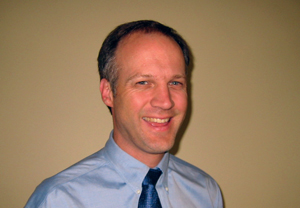 Name: John Haughton, MD
Name: John Haughton, MD
Home State: Maryland
John has been participating in clinical research for 25 years.
Why? John’s doctor sent him to the Clinical Center because John, a high school student at the time, had a fairly rare tumor. The experience opened his eyes to the complexity of medicine.
John’s story: They say cancer changes your life. In John Haughton’s case, treatment for cancer at the Clinical Center changed it.
John’s journey to the NIH was a short one. He injured his leg when he was 18, a senior at Bethesda–Chevy Chase High School. As a pole-vaulter and runner, he was used to injuries, but this was different: His swollen calf hurt too much. The local hospital sent him to a local orthopedist who recognized the shadow on his X–ray as a telltale sign of a fairly rare tumor. The orthopedist picked up the phone, and within a week John was a pediatric oncology patient of the National Cancer Institute.
The diagnosis was Ewing’s sarcoma, a rare cancer of the long bones that often required partial amputation. But John was lucky. Surgeons successfully removed the tumor and part of his fibula, and he kept his leg. During the radiation and chemotherapy that followed, the NIH staff adapted to his senior-year schedule. He rode his moped to the Clinical Center for lunch-hour radiation treatments during high school and, when he started college, they wrote a letter requesting schedule accommodations for trips back to Bethesda.
During the following year of chemotherapy, John’s attending physician and almost everyone he encountered at the NIH went out of their way to make him feel like a person, not just a patient. The chemotherapy fellows helped him sift through the meaning of various research studies and opened his eyes to the complexity of medicine. John began rethinking his future. He had planned to study engineering in college — he was a systems person, who hated dumb systems — and he could see that medicine had not only many systems but also many unanswered questions, large and small.
Not so long ago, he had thought there was just one kind of cancer. Now he knew there were many kinds and many cures. And he could see problems begging for solutions. He decided to combine engineering and medicine, bringing the perspective of both patient and health care provider to creating systems that work for everyone. With dual degrees in medicine and engineering, John specialized in rehabilitation medicine. He is working on computer systems to help healthcare providers provide easier, safer, better-coordinated, and more convenient health care.
Now 43 and cancer-free, he enjoys spending time with his family, as often as possible on the water. He also serves on the Clinical Center’s Patient Advisory Committee, a group that helps shape smarter systems — and is listened to. When patients reported that the speed bumps in the patient parking garage made patients in chemotherapy sick, the bumps were immediately removed. It’s a system that works.
Read more stories
|